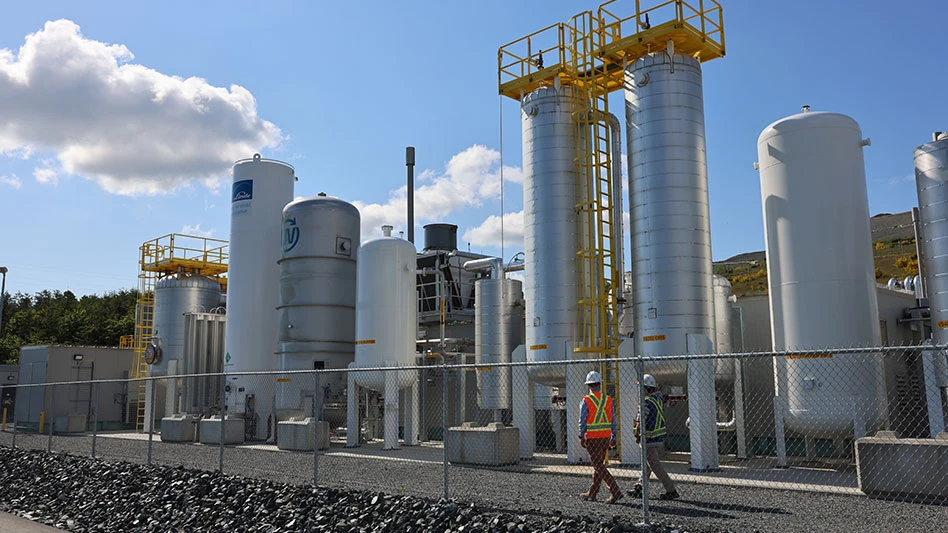
Photo courtesy of FortisBC Energy Inc.
Working with FortisBC Energy Inc., a British Columbia-based renewable natural gas (RNG) company and Waga Energy Canada, Quebec, the Capital Regional District (CRD) has started producing RNG at a new facility located at the Hartland Landfill in British Columbia.
The CRD is a regional government on Vancouver Island, and the Harland Landfill RNG facility is Vancouver Island’s first RNG facility.
The nearly $23.22 million Hartland RNG facility is designed to use Waga Energy’s Wagabox technology and to produce a maximum of 341.214 million British thermal units (MMBtu) of RNG annually. FortisBC says that this will reduce the capital region’s greenhouse gas (GHG) emissions by up to 475,000 tons of carbon dioxide over the next 25 years, the equivalent of removing the total emissions from 105,000 homes in Canada over the facility’s lifetime.
At the facility, landfill gas, released from decomposing waste, is captured and then injected into FortisBC's gas system. According to the company, by turning landfill waste into a lower carbon energy source, this initiative not only supports the province's climate action goals but also demonstrates how locally sourced products can help reduce reliance on conventional natural gas.
FortisBC says the facility aligns with its commitment to address climate change within its operations and across the region and is an example of how the company is working with local governments to develop renewable and lower carbon gases. When RNG is added to North America’s gas system, it mixes with conventional natural gas. The more RNG is added to the gas system, the less conventional natural gas is needed, thereby reducing the use of fossil fuels, FortisBC says.
Waga Energy will operate and maintain the facility on the CRD’s behalf for 25 years, the companies say, while the CRD continues to be responsible for the ownership and operation of Hartland Landfill and the landfill’s gas collection system. FortisBC will pay a fixed price per gigajoule for the RNG and will be responsible for the costs associated with injecting the RNG into its gas distribution system. The new landfill gas upgrade facility will be fully self-funded through revenues from biogas sales.
The CRD is a regional government on Vancouver Island, and the Harland Landfill RNG facility is Vancouver Island’s first RNG facility.
The nearly $23.22 million Hartland RNG facility is designed to use Waga Energy’s Wagabox technology and to produce a maximum of 341.214 million British thermal units (MMBtu) of RNG annually. FortisBC says that this will reduce the capital region’s greenhouse gas (GHG) emissions by up to 475,000 tons of carbon dioxide over the next 25 years, the equivalent of removing the total emissions from 105,000 homes in Canada over the facility’s lifetime.
At the facility, landfill gas, released from decomposing waste, is captured and then injected into FortisBC's gas system. According to the company, by turning landfill waste into a lower carbon energy source, this initiative not only supports the province's climate action goals but also demonstrates how locally sourced products can help reduce reliance on conventional natural gas.
FortisBC says the facility aligns with its commitment to address climate change within its operations and across the region and is an example of how the company is working with local governments to develop renewable and lower carbon gases. When RNG is added to North America’s gas system, it mixes with conventional natural gas. The more RNG is added to the gas system, the less conventional natural gas is needed, thereby reducing the use of fossil fuels, FortisBC says.
Waga Energy will operate and maintain the facility on the CRD’s behalf for 25 years, the companies say, while the CRD continues to be responsible for the ownership and operation of Hartland Landfill and the landfill’s gas collection system. FortisBC will pay a fixed price per gigajoule for the RNG and will be responsible for the costs associated with injecting the RNG into its gas distribution system. The new landfill gas upgrade facility will be fully self-funded through revenues from biogas sales.
Latest from Waste Today
- BTS Bioenergy opens Maryland Organics Recovery Center
- Meadow tabs aluminum as key to boosting beauty sector recycling
- LFG-to-energy: Maximizing returns with multitiered methane monitoring
- FCC completes acquisition of Florida WTE facility
- Casella to acquire Mountain State Waste
- Landfill Insights | Airspace Part 5: Tracking your landfill AUF
- Missouri city expands recycling capabilities with funding from The Recycling Partnership
- Recycle BC portrays its end markets





